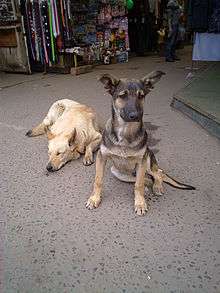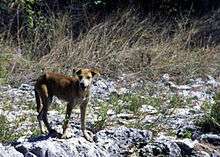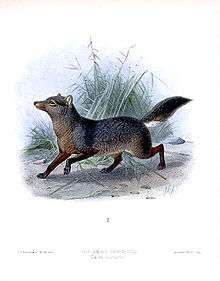Free-ranging dog

A free-ranging dog is any dog that is not contained. Free-ranging dogs include wild dogs, feral dogs, stray dogs, street dogs, and village dogs, as well as dogs allowed to come and go freely by their owners. The term is used when distinctions of ownership are irrelevant. It sometimes overlaps with the polysemic term pariah dog. The World Health Organization reports that there are 200 million stray dogs worldwide.
Rural versus urban free-ranging dogs


Ecologists find it important at times to distinguish between urban free-ranging dogs and rural free-ranging dogs. The distinction can be important as the ecological impact of, and evolutionary pressures on, these groups can be quite different.[1]
Village dogs
Rural free-ranging dogs that rarely if ever leave a settlement are called village dogs. They are considered neither wild nor feral, and have less impact on the surrounding ecosystem than other rural free-ranging dogs. They pose a different set of environmental pressures than feral or wild dogs, or even free-ranging farm dogs.[2] Experts on the behavior of early and primitive dogs have also noted interesting physical and behavioral differences between village dogs and other more feral free-ranging dogs. For example, village dogs tend to be smaller and occur more often alone or in pairs.[3]
Village dogs include the African village dog and East Asian village dog, two types that were the earliest to be domesticated.
Pariah dogs

The term pariah dog has been used inconsistently, but is sometimes used synonymously, if incorrectly, with free-ranging dog. Originally, it referred to the landrace of free-ranging dogs native to India and other Asian countries. It later came to be used for primitive natural breeds of dogs of a similar physical appearance in other parts of the world. The United Kennel Club has a category of dogs called the "Sighthound & Pariah Group", which includes: primitive dogs; distinctive, local, free-ranging landraces; breeds recently developed from naturally selected populations; and very ancient breeds.[4]
Pariah dogs are canines that have kept close to the original form and have evolved with little or no purposeful human intervention. Pariahs in all countries tend toward a very similar, typical morphology known as the "long-term pariah morphotype".[5] This primal body design resembles the ancient breeds from which most other dog forms derive. Typically, these canids have a spitz-like appearance: a wedge-shaped head with a pointed muzzle, almond eyes, erect ears, and a long, tail curved over the back. Unlike modern breeds, pariah dogs have one annual estrus cycle.
Primitive or pariah dogs include the Aspin dog, a native Philippine breed, the Indian Pariah Dog, the Indian Santal dog, the Indonesian Bali Dog, the Korean Jindo Dog, the South African Hottentot dog, and the American Carolina Dog.[6]
Stray versus feral
Experts in the area of free-ranging dog control sometimes distinguish between stray dogs and feral dogs. Stray refers to lost and abandoned pets, or others that had socialized to humans before taking to the free-ranging life—and feral to dogs that have lived all their lives apart from people. This distinction is important to them, because stray dogs can be relatively easily taken into captivity, whereas feral dogs are more fearful and difficult to keep as pets, and so are more often captured, spayed or neutered, and released back into the parks, vacant lots, and other hiding places on the margins of human society where they are most commonly found.[7] Feral, (from Middle French feral "wild," from Latin fera, in phrase fera bestia "wild animal," from ferus "wild"), implies the progeny of formerly domesticated animals, run wild, having escaped from domestication. Feral dogs include the second generation offspring of former strays which, having had little or no contact or bonding with humans, may have formed pack communities and reverted to instinctive canine behaviors. They may scavenge for food on the periphery of human populations.
In other contexts, and generally in Indian English, the term "stray dog" covers both feral dogs and dogs that have strayed from their owners. India has a population of feral dogs numbering in the tens of millions, the highest in the world, and millions of people are bitten every year, with about 20,000 people dying annually from rabies. When discussing these issues in the Indian context, distinctions between stray and feral dogs are less clear or important, so the term "stray dog" is used to cover both stray and feral dogs, and to distinguish them from the wild dog of India.[8]
The term wild dog
Wild dog may refer to:
- Feral populations of domestic dog (classified as a subspecies of the gray wolf).[9]
- Wild populations of dogs classified as different subspecies from the domestic dog, but ultimately derived from it. (See § True wild dogs, below.)
- Any of several wild canine species that are commonly called dogs but are not subspecies of the grey wolf, but within the same genus, Canis, such as actual gray wolves, most other wolf species, jackals, and the coyote.
- Any wild canid – a member of the dog family of carnivores (Canidae) – in a genus other than Canis, including foxes, the maned wolf, and several species called "dogs" in the vernacular, including the African wild dog, Indian wild dog (or dhole), bush dog, short-eared dog, and raccoon dog. They are commonly contrasted with canids labeled dogs in other contexts, and are generally not capable of fertile if any offspring with members of genus Canis. (See Canidae § Phylogenetic relationships for more information.)
True wild dogs
As a technical term, wild dogs is not used in scientific literature to refer to domestic dogs sub-classified as Canis lupus familiaris, no matter how feral or "wild" they may be. It is reserved exclusively for some dogs classified as Canis lupus dingo which have become more wild animals rather than simply feral: Australian dingoes; sometimes some Australian dingo/dog hybrids; and some literature refers to the New Guinea singing dog as being wild but others disagree. The term is sometimes also applied to others canines from Southeast Asia and Australasia. While still listed taxonomically as 'domestic dogs', they are considered wild rather than feral domesticated animals, even when raised in captivity.[1]
Feral versus wild
In scientific literature, free-ranging dogs such as Australian dingoes are considered 'wild animals' rather than 'feral' to the extent to which they are not 'commensal': dependent on handouts and cast-offs from humans; and instead hunt and scavenge in the wild. Ecologically, wild dogs are integrated into the ecosystem, often as top predators. Evolutionarily, wild dogs are profoundly different from their domestic counterparts, due to many generations apart from people, versus many generations of being selectively bred by them, respectively. Both wild dogs and adult feral dogs are less easily kept as pets than free-ranging or captive dogs that have been socialized to humans. Unlike feral dogs, however, wild dogs tend to maintain their wild nature even when taken in as puppies.[1]
Other species called wild dog

.jpg)
Two canid species have common names specifically calling them wild dogs, but are entirely different species from the domestic dog (Canis lupus familiaris): the African wild dog (Lycaon pictus,) and the Indian wild dog (Cuon alpinus), more commonly known as the dhole. They are not closely related to each other nor to true dogs, and may be simply called "wild dogs" locally or when the species or geographical location is already known or implied.
Other wild canids called dogs
There are two South American wild canid species commonly called dogs in English: the small-eared dog (Atelocynus microtis) and the bush dog (Speothos venaticus). These are not very closely related to each other, and even more distantly related to true dogs than African and Indian wild dogs.
Not as easily mistaken for a true dog is the wild raccoon dog (Nyctereutes procyonoides), a quite primitive wild canine native to the Far East named for the fact that it looks as if it were a cross between a dog and a raccoon. It is more distantly related to true dogs than any other extant canid.
-
The bush dog
Rabies impact
A article from 2011 on the Stray Dog Population by the US National Animal Interest Alliance says that the rabies epidemic in stray dogs around the world has transformed into a global public health issue.[10] The World Health Organization reports that there are 200 million stray dogs worldwide, and dogs are responsible for the vast majority of human rabies deaths, contributing up to 99% of all rabies transmissions to humans. More than 55,000 people die from rabies each year, and more than 15 million people receive post-bite rabies vaccines to prevent the disease.[11] 20,000 of these deaths occur in India due to its large stray dog population.[8]
Conservation impact
Increasing numbers of free-ranging dogs have become a threat to the snow leopard on the Tibetan Plateau because they chase these, and young brown bears, away from food.[12]
See also
References
- 1 2 3 Vanak, ABI Tamim; Gompper, Matthew E. (2009). "Dogs Canis familiarisas carnivores: Their role and function in intraguild competition". Mammal Review. 39 (4): 265. doi:10.1111/j.1365-2907.2009.00148.x.
- ↑ http://snr.missouri.edu/fw/faculty/pdf/gompper/intraguild-competition.pdf| http://snr.missouri.edu/fw/faculty/pdf/gompper/intraguild-competition.pdf
- ↑ "Dogs". google.com.
- ↑ http://www.ukcdogs.com/WebSite.nsf/WebPages/LrnBreedInfoByGroup
- ↑ Masson, Jeffrey Moussaieff - How Dogs Have Captured Our Hearts for Thousands of Years, ISBN 9780061771095
- ↑ "Primitive Dogs (Introduction)". bulldoginformation.com.
- ↑ "Pet Care Information - Healthy Pets - Best Friends Animal Society" (PDF). bestfriends.org.
- 1 2 Gardiner Harris (August 6, 2012). "Where Streets Are Thronged With Strays Baring Fangs". The New York Times. Retrieved August 7, 2012.
- ↑ "U.S. Facing Feral-Dog Crisis". nationalgeographic.com.
- ↑ "The Global Stray Dog Population Crisis". National Animal Interest Alliance. Retrieved 4 July 2014.
- ↑ "Rabies - Fact Sheet N°99, Updated 2013". World Health Organization. Retrieved 4 July 2014.
- ↑ Understanding Dogs to Protect Cats by Luke Dollar, National Geographic 2016



